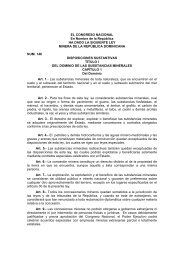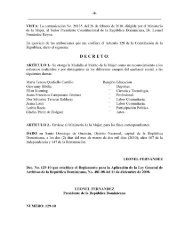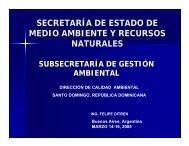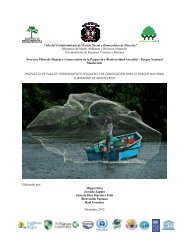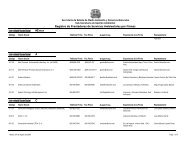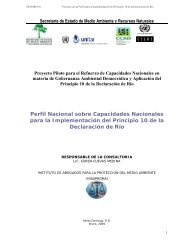CAMBIO CLIMATICO
CAMBIO CLIMATICO
CAMBIO CLIMATICO
You also want an ePaper? Increase the reach of your titles
YUMPU automatically turns print PDFs into web optimized ePapers that Google loves.
REPÚBLICA DOMINICANA 2003<br />
measures will achieve a reversal in the negative<br />
impact of climate changes in tropical zones in the<br />
case of highly adverse scenarios.<br />
Regarding the adaptation of our forests, these<br />
should be protected against indiscriminate<br />
exploitation by developing reforestation plans<br />
with scientific techniques that guarantee the<br />
planting of new woodlands. In areas with the<br />
most difficult conditions, it is advisable to<br />
employ successive reforestation techniques.<br />
Although it is not always economically justifiable,<br />
one should keep in mind the possible use<br />
of irrigation in forest areas, provided that the<br />
availability of water allows it.<br />
1.4.4 Health Sector<br />
Regarding the annual behavior of malaria in the<br />
country, as of 1965 there was a trend toward a<br />
reduced number of cases that ended with the<br />
close of the decade of the 70s. Later, an increase<br />
in the number of cases was maintained at an<br />
endemic plateau that has been evident for the<br />
last 20 years. The pattern of malaria transmission<br />
affects the same group of provinces, as<br />
shown on the map for the period 1991-2000.<br />
Two areas of the highest risk of transmission are<br />
the Sub-region of Yuma in the East and the<br />
Western Cibao Sub-region in the Northwest.<br />
In the first, malaria transmission has been related<br />
to the cultivation of sugar cane and the intensive<br />
construction of tourist facilities, both of<br />
which are linked to the strong migration of<br />
workers, seasonally for sugar cane and in a concentrated<br />
and explosive form for construction,<br />
while in the Western Cibao it has been related to<br />
the cultivation of rice, other agricultural crops,<br />
and the temporary seasonal migration of the<br />
labor force.<br />
1.4.4.a) Impact of variability on the<br />
behavior of diseases<br />
For the study of seasonal patterns, the series<br />
was subdivided into two sub-periods. One period<br />
corresponds to the baseline (1988-1994) and the<br />
other to current conditions (1995-2000), which<br />
correspond to the changes observed in the seasonal<br />
pattern and the trends discussed in the<br />
preceding section.<br />
The trends observed regarding malaria coincide<br />
with the regional trends manifested in the climate,<br />
which beginning in 1975 highlight<br />
changes in precipitation patterns with a tendency<br />
toward a decrease along with a slight variation<br />
in humidity, as well a warming trend that,<br />
although slight and not significant, has already<br />
begun to show signs that the region is warming.<br />
It is interesting to note that here there is no clear<br />
evidence between outbreaks and ENSO event<br />
conditions, since in 1999 there was an increase<br />
and we were not under ENSO event conditions,<br />
but under those of AENSO.<br />
1.4.4.b) Effects of Climate Variability<br />
on Diseases<br />
The results achieved corroborate the hypothesis<br />
that climate is a modifying factor in the epidemiological<br />
patterns of malaria; in fact, it has been<br />
changing them as the climate has changed in the<br />
region, where the disease appears during periods<br />
that are not very different from each other, with<br />
high temperatures and trends toward increased<br />
relative humidity as a result of the start of precipitation.<br />
These conditions favor the proliferation of<br />
pathogens in the appearance of epidemics.<br />
1.4.4.c) Evaluation of Physical Impacts<br />
There is scientific evidence that demonstrates<br />
that the diseases studied in this evaluation are<br />
susceptible to the effects of climate change<br />
(Ortiz, 1995; Ortiz, 1996, CONAMA, CNCC, 1999;<br />
IPK, 1999). Many of the biological organisms<br />
and processes linked to the appearance of infectious<br />
diseases are particularly influenced by<br />
fluctuations in climate variables, especially temperature,<br />
precipitation and humidity<br />
(McMichael, A.J., and et al, 1996). The regional<br />
climate change has altered the pattern in the<br />
number of infectious diseases and of diseases<br />
produced by food poisoning, among others.<br />
48



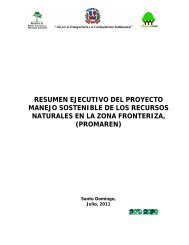
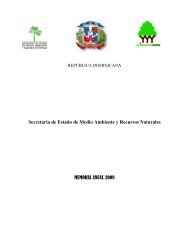

![Documento de trabajo del grupo G-77[1] EconomÃa verde en el ...](https://img.yumpu.com/50859069/1/190x245/documento-de-trabajo-del-grupo-g-771-economa-a-verde-en-el-.jpg?quality=85)




